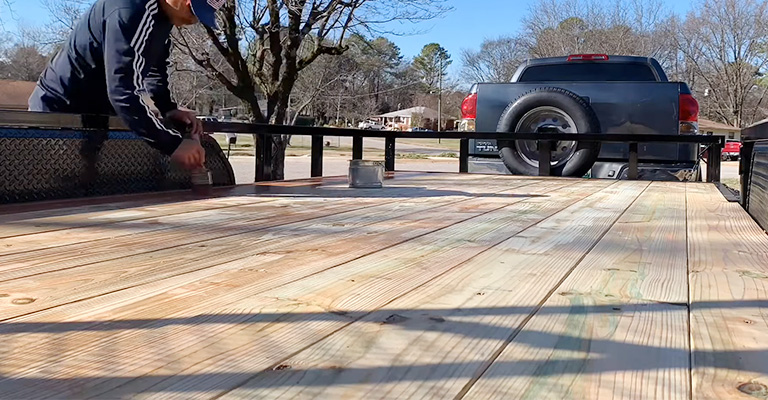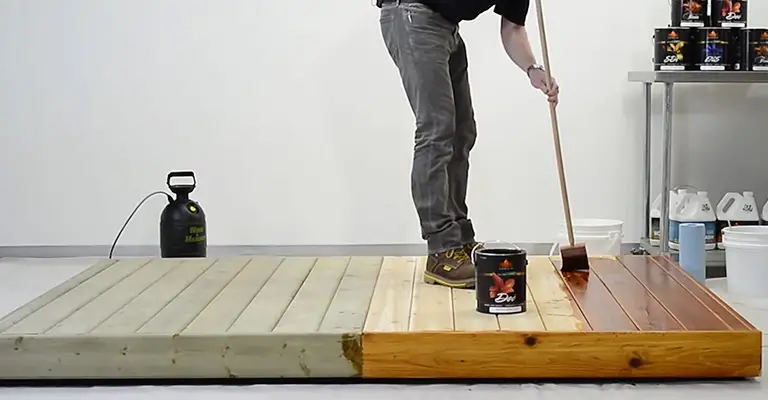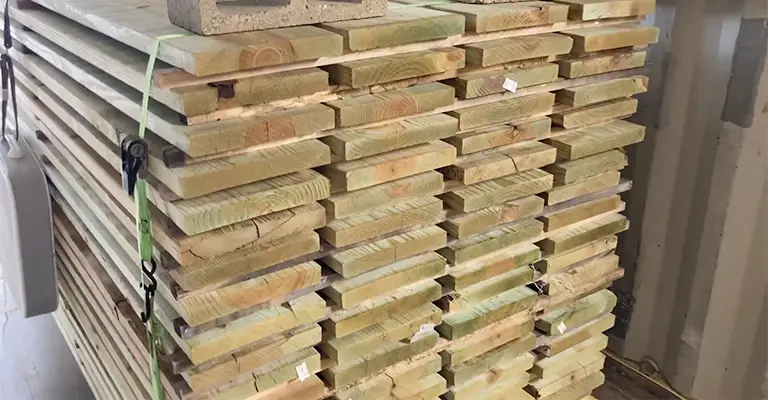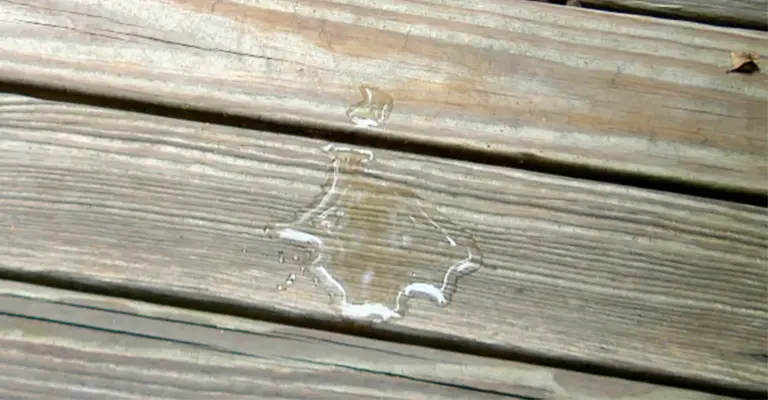Pressure-treated lumber is ready to be painted or stained as soon as it is dry after the treatment process.
This typically takes at least a few days, but it can take up to several weeks, depending on the climate and the thickness of the lumber.
It is essential to wait until the lumber is completely dry before applying paint or stain, as using it to dampen wood can cause the finish to peel or chip.
It is also a good idea to clean the wood and allow it to dry completely before applying the finish to ensure that it adheres properly.

Can You Paint Pressure Treated Wood?
Pressure-treated wood is often questioned: can it be painted? The answer is yes, but there are a few things you need to consider. You need to take additional steps when working with lumber that doesn’t require them.
Paint needs to be applied after pressure-treated lumber has dried completely. You will have the best chance of success if you show a little patience and apply the proper paint and primer.
When Can You Paint Pressure Treated Wood?

It is necessary to let pressure-treated wood dry out before it is primed or painted.
A total decrease in moisture levels can take three to four months. There is still too much moisture if moisture beads up on the surface.
Once the treated wood absorbs water rather than repelling it, it is ready to paint. You will most likely have to wait a while before using the pressure-treated lumber you bought at the hardware store.
In addition to resin and pitch, there are also chemicals in the wood that require time to dry out.
Putting paint on too soon can make your lumber decay and deteriorate much faster than it would if it was allowed to cure properly.
The drying-out process will take longer depending on where you live and the weather. The cure time of treated wood will be much longer in areas with extreme humidity.
There is a significant speed-up in the process in cities such as Sacramento, with arid and dry climates.
Here is a way to test the wood to see if it is ready for staining:
Take a small sample of boards and wet them with water.
Repeat the test several times each to determine if the water beads up (not ready for liquid – not ready for staining) or soaks into the wood (willing to accept liquid and ready for staining).
Staining the wood in a couple of weeks is possible, though the general advice is to wait a month if you can.
Be aware, however, that if the drying conditions are poor, you might have to wait a couple of months.
Using the same stains on different materials is generally possible, but you may want to use decking stains in certain locations.
When Is the Best Time to Paint Pressure Treated Wood?

Once pressure-treated wood has dried and been cleaned, you should paint it. As a result of pressure-treating lumber, chemicals are introduced deeply into wood fibers through the water.
Consequently, the wood emerges from the treatment chamber extremely wet. Depending on its thickness and type of treatment, it can take several months for the treated wood to dry out enough to be painted.
Several factors affect the dryness of the wood, including:
- Whether the wood is thick or thin
- Storage location
- The treatment is given to it
- The wood’s kiln-dry status
Here are a few more details to consider.
The Thickness Of Treated Lumber Affects The Drying Time
It is possible to pressure treat almost any type of lumber if you are familiar with treated lumber.
Compared to a two-by-six, plywood or fencing is thinner. In this way, you can expect thinner-treated lumber to be ready for painting before thicker lumber.
Storage Of Pressure-Treated Wood Should Be Considered

The drying process of pressure-treated wood takes much longer in a cool, dark environment. There may be no immediate need for the treated lumber. It should last for a long time, right?
That’s sort of true. Surface-treated wood will undoubtedly remain resistant to rot and insects, but mildew can still affect it.
Your wood might, however, be stored in a warm, dry environment. The advantage is that you will be able to dry your lumber quicker, but there is also a disadvantage.
Wood that has been pressure-treated is more likely to warp when exposed to high heat. If you are painting treated lumber, consider where it was stored before you paint.
Time Since Pressure Treated Wood Was Treated
Inquire about the arrival date of the pressure-treated wood at your lumber yard. By determining whether the wood has dried, you can get a general idea of how long it has taken.
However, it is important to note that other factors are involved. At the hardware store, treated lumber is usually stacked tightly in bundles.
The tight stacks make it difficult for equal dry times to occur. Consequently, some boards are drier than others.
Kiln Dried Treated Lumber

It is common for treated lumber to be kiln-dried before being sold. A kiln uses a large heater to bake all the moisture out of wood. A controlled kiln reduces warping by doing this in a controlled manner.
For lumber that is ready to paint, kiln-dried treated wood is the best option. Getting that project done fast will be more expensive, but it might be your best choice.
How Do You Tell When Pressure Treated Wood Is Dry?
The following section discusses several ways to determine if your treated wood is ready for painting. If you want to know whether pressure-treated wood is dry, follow these steps:
Testing Treated Lumber For Moisture With A Digital Moisture Meter
Using a digital moisture meter is the final method of testing the moisture content of your treated lumber. To test the moisture content of wood, you press two prongs into the wood.
Make sure your digital moisture meter is properly calibrated before using it. Averaging your results from several spots on the board is also a good idea.
Performing A Water Test On Pressure-Treated Wood

If the first test does not show any moisture, there is another way to determine whether your wood is dry.
Several drops of water should be poured onto the wood surface from a cup. Wood is ready to be painted if it soaks up water from the water.
However, it indicates that there is too much water within the wood when the water beads on the surface.
There might be some sufficiently dry wood, but is the entire board? What would be the best way to clean the board without dousing it in water?
Test For Pressure-Treated Wood By Feeling It
Using your eyes and hands, you determine whether the wood is dry by looking over it. If the wood fails this test, you do not need to bother with the next two tests.
See any moisture in the wood by pressing your hand or using a paper towel. The moisture will ooze out of wet wood, just like a sponge.
This test will only determine whether or not your wood is still wet – not whether or not it is dry enough to paint! The reason wood takes so long to dry is that it is very absorbent, like a large sponge.
How To Paint Pressure Treated Wood?
Cleaning the wood thoroughly is the first thing you need to do before painting. Remove dirt and debris from the wood by washing it with soap and water.
Using a clean rag may be necessary to be as thorough as possible. Afterward, wipe it down with a dry rag and let it dry completely.
1. Let The Wood Dry
After treating the wood and cleaning it with water, the lumber needs time to dry out due to the chemicals used. A few weeks and a few months can pass through this process.
After pressure treatment, kiln-drying the wood will speed up the drying process. You should choose kiln-dried wood if you have a project that must be completed immediately.
2. Apply A Coat Of Primer
You can apply primer to your wood once you’ve tested its moisture and confirmed that it’s dry. If you are painting treated wood or exterior wood, use a primer listed on the label as suitable for both.
3. Apply Paint Or Stain
Following the priming and drying of the primer coat, you can apply the paint or stain. Even though the stain is easier to apply, it won’t fill in cracks or give you as many color options as paint.
It is possible to paint pressure-treated wood to make it look different and cover up any blemishes or cracks. Applying two coats of paint is recommended if you choose to go this route.
You’re better off sticking with latex over oil-based paints if you’re painting treated wood. Even though it will take a little longer, a double coat will provide more protection from the sun and elements.
What Happens if You Paint Pressure-Treated Wood too Soon?
The moisture content of pressure-treated wood is high after the wood has been treated initially. When you purchase treated lumber, it is likely to be damp unless it has been kiln dried.
Before painting treated wood, I always recommend waiting until it is completely dry. Painting too soon won’t result in a quality finish. The following happens when pressure-treated lumber is painted before it’s ready:
Your Board Will Warp
As we mentioned in the last section, wood shrinks slightly as it dries. The shrinking of a board is also what causes it to warp.
A board that shrinks faster on one side than on the other will pull towards the shrinking side when one side shrinks faster than the other.
The non-painted side of treated lumber dries faster if you paint it before it is dry. Consequently, warping occurs when one side dries faster than the other.
When the wood is dry, it won’t warp, the paint won’t peel, and you won’t have to deal with a big project.
Your Paint Will Peel
The paint can’t adhere properly to the wood fibers when you paint over-treated wood that hasn’t dried. Therefore, you get paint that flakes much earlier than if your wood had been completely dried.
It is natural for a board to shrink a bit as it dries. This slight shrinkage of the wood will further accelerate paint peeling. After that, what happens? The old paint must be removed with a sander and a new coat sprayed.
Paint Won’t Dry on Damp Treated Lumber
The problem with painting pressure-treated wood before it’s ready is that you are essentially locking moisture in the wood and making it impossible to escape.
As a result, chipping and peeling may occur, but the paint may not dry properly. Due to the damp board, moisture will wick into the paint, preventing it from curing properly. It is a liability to apply paint that isn’t dry for several reasons.
First of all, it is more likely to be damaged during the drying process. There is a greater risk of dents and scuffs on a soft surface because the paint hasn’t hardened.
Final Words
Ensuring treated wood is dry is the most important factor in painting it. Depending on where the wood was stored, if it had been kiln-dried, and its thickness, you can determine if the treated lumber is fully dry.
The board is ready for painting if several beads of water absorb onto its face; if they do not, it does not have enough moisture.
The process of painting treated wood requires patience. In the long run, you will end up with more work if you rush the process.







